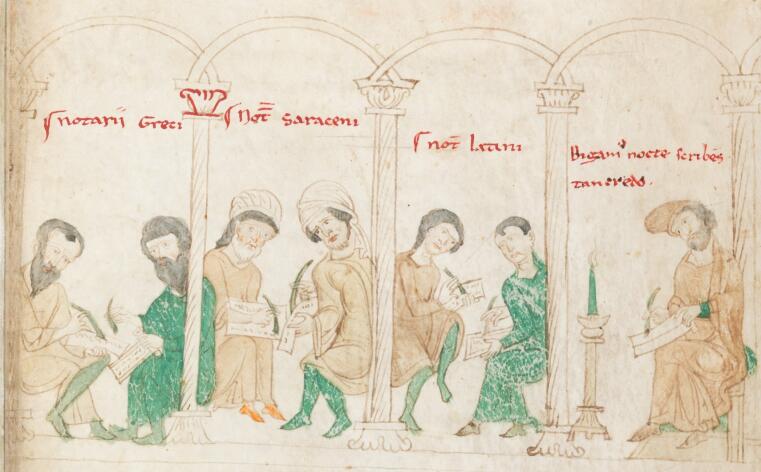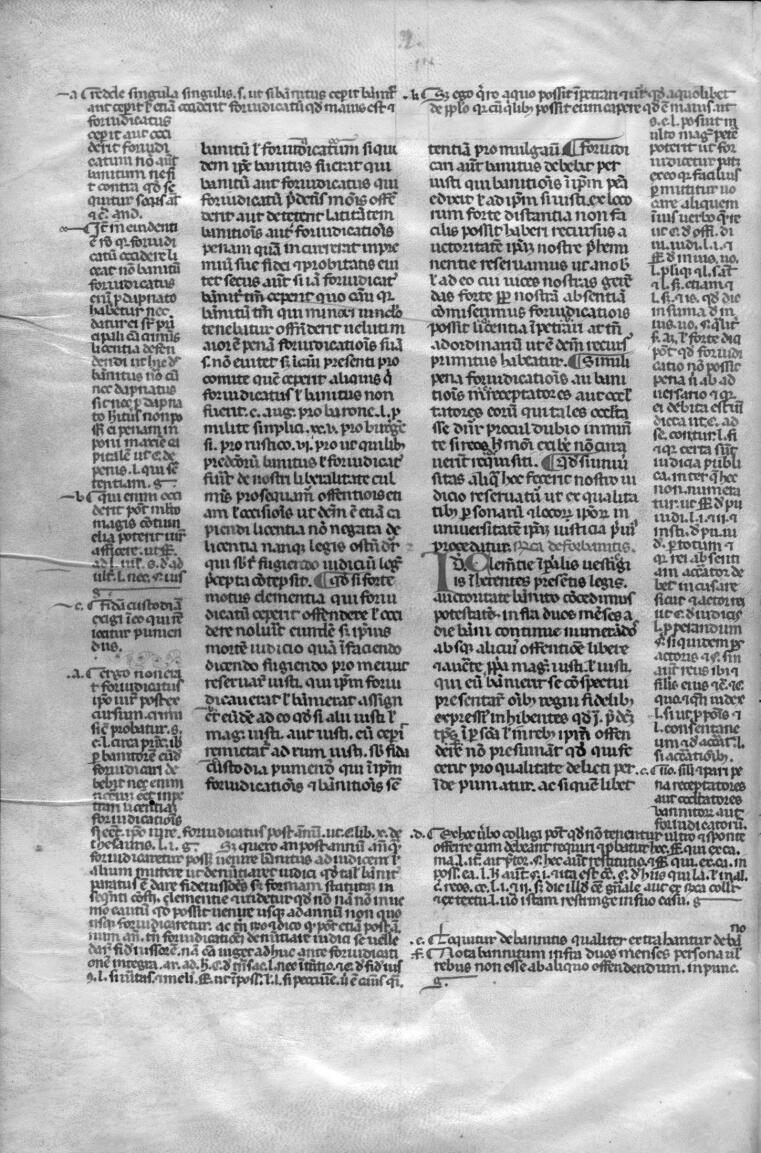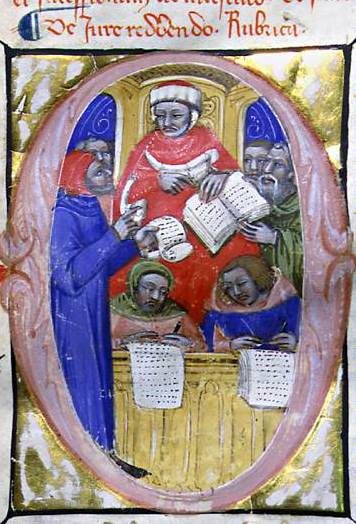“Jurisprudence is a strong unifying factor in the Middle Ages”
Interview with Susanne Lepsius on law in the Middle Ages
Susanne Lepsius has set her sights high: she is working at the Kolleg on a general volume that is intended to introduce readers with no previous legal knowledge to the broad subject of “Law in the Middle Ages”. An important basis for this project is her soon-to-be-completed work editing the oldest glossary of the Constitutions of Melfi, a legal text promulgated by Emperor Frederick II for the Kingdom of Sicily. As early as the 13th century, so-called glossators began to order the ruler’s decrees in a certain way, and to compare them with existing law. The editorial work of Lepsius and her team yields new insights not only into how the glossators actually did their work, but also into what Hohenstaufen jurisprudence was interested in. A conversation about the unifying effect that medieval jurists had, the practical challenges of editing glosses, and the status of law in medieval societies.
Professor Lepsius, you have been a Fellow at the Käte Hamburger Kolleg in Münster since April. What were your expectations when you took up your fellowship, and how far have these been fulfilled so far?
My expectation was that I would have a year when I could finally devote myself to research projects again, because that’s why I became a professor in the first place. And especially in the last couple of years, due to Corona, what has been so central is the whole reorganisation of teaching, examinations, and talking to and organising staff – so that you develop a real tunnel vision and don’t have the peace and quiet to broaden your horizons. That’s why, from my point of view, it was extremely important for me personally and biographically, and I’m very grateful to have the space this year to think and finally also to read again. And that’s what I’ve done in the last six months. I have also been able to complete many smaller projects that fall under the main topic of “Law in the Middle Ages”, while gathering material for the larger project. The other positive effect is that I can have interesting conversations about common research problems with many colleagues here, for example over lunch, or even just pop in to a neighbouring office for a chat.
One of your sub-projects from the cosmos “Law in the Middle Ages” deals with the Constitutions of Melfi. Can you first explain what this is about?
Together with a post-doctoral researcher we received a DFG which allowed us to embark on this editorial project. We are editing the oldest glossary of the Constitutions of Melfi, the so-called Apparatus Vetus. My task in this project is to resolve, check and critically prove the legal allegations, i.e. references to Roman, canonical or Lombard law. The project will soon be completed, then go to print, and possibly also be published digitally.
The Constitutions of Melfi were issued by Emperor Frederick II for his Kingdom of Sicily at the Melfi court day (Hoftag) in 1231. The term Constitutions was deliberately chosen because Frederick saw himself as the successor of the ancient emperors who themselves had issued many constitutions. The period of Frederick’s reign also saw the issuing of further constitutions, so-called novellae, at later diets, thus also following the ancient imperial tradition. According to my findings, one particular task of this oldest glossary was to systematise the various constitutions and put them in order, i.e. to make a stringent code of law out of them. This could be called the Liber Augustalis, although use of this term can only be verified since the 19th century.
"Frederick was primarily concerned with bringing order to the judicial system”

Apart from the example of the ancient emperors, what motivated Frederick to issue the Constitutions?
The question of Frederick’s motives is difficult to answer, not least because it has attracted so much historiography. One could, for example, refer to a famous constitution, where Frederick describes himself enthusiastically as the “father and son of justice”, for which reason he considers it necessary to issue these constitutions for the good order of the kingdom. But this of course is political propaganda. If you look at the areas of regulation in the constitutions, he was probably primarily concerned with bringing order to the judicial system and giving the judicial process a clearer organisation. Historiography has given great emphasis to this interpretation, and has praised Frederick II, who as the supposed “first modern man on the throne” has always fired the imagination of historians, for issuing a codification. But that was certainly not what he had in mind. Nor are the Constitutions what we as legal historians today would understand as a codification, because they did not have the general aspiration of regulating all relevant areas of law. Civil law, for example, is hardly mentioned, but rather criminal law and the judiciary. The aim was probably to unify the kingdom and to eliminate the structures of fiefdom of the powerful barons.
So unification was indeed the goal?
A unification of the judicial apparatus, but not of substantive law. We legal scholars usually think of laws as codes of law and examine them to see what, so to say, should be regulated in terms of substantive law. If we look at the Constitutions through such a modernist lens, then we can of course find deficits. The regulations of civil law should, for example, include inheritance law, family law, personal law, the law of obligations, but also commercial and merchant law, etc. But hardly any of this is found here. Even the criminal law refers only to very specific issues, e.g. lèse majesté and the prosecution of heretics. Instead, Frederick’s code contains what we would today call public law. For example, it formulates a kind of professional ethics for pharmacists, who are not allowed to sell bad substances or be doctors at the same time.
You write in your new essay, and this surprised me, that it is the “most important task of the king as supreme ruler of the courts to respect and guarantee the pluralism of systems and jurisdictions”. What do you mean by that?
One of the guiding themes of the Käte Hamburger Kolleg, pluralism is of course not a term that appears in the code of law, but we can certainly use the term to describe the Constitutions. Friedrich did not want to impose substantive law. Perhaps he focused so much on procedural law because he had a very plural kingdom to rule: there were different language communities such as Latin, Greek, Norman, and Arabic. Moreover, the Lombards had developed their own form of jurisprudence and thus an alternative legal system since the time of the migration. When Frederick speaks of the ius commune in his kingdom, he usually does not mean the learned Roman law, but the Lombard law. And then of course there was feudal law and the church with its canon law. Frederick, for example, granted to the church its own jurisdiction and conceded that clerics could only be cited before his royal court in special cases such as capital crimes. He did not want, as Ernst Kantorowicz has described it, to enforce state law and level other rights. Rather, he and his legal advisors had to take note of this pluralism.
“It is exciting to see that there were other centres of jurisprudence besides Bologna so early on”

Let us turn to the sources. Frederick had now issued the Constitutions and the glossators soon began their work. What exactly do they do?
We can of course only deduce that from the surviving manuscripts. We have a lead manuscript that we are editing that dates back to before 1270. Basically, this looks exactly like a gloss on Roman or canon law, something that has had a certain form since the 13th century. It is called a bracketing gloss: the legal text to be commented upon is placed in two columns in the middle of the page, while the glosses are placed around the outside. These are interlocked with individual words in the main text by small index letters, these individual words being underlined or highlighted with a certain colour so that the reader can see which gloss explains which word in the main text.
Interestingly, the manuscript we are editing has pages that are completely full of glosses, while others have very few glosses. Thus, and this has not been noted by scholars so far, the glossators have particular issues that they are interested in. We are entering new territory by looking at the oldest apparatus: what did the first three glossators in the Hohenstaufen period consider worthy of glossing? From the perspective of the history of science, it is also exciting to see that there were other centres of jurisprudence besides Bologna so early on. Probably the earliest of the three glossators, Guisandus de Rubo, was a contemporary of the famous Bolognese legal scholar Accursius.
Who were these glossators, and why did they write their glosses?
Unfortunately, the glossators don’t tell us – they just get on with their job! Unlike in Bologna, we think, they do not do it for the purposes of teaching, since characteristic features of the Bolognese glosses are missing, e.g. the address of a professor to an audience, disputes between different schools of law, or simple explanations of words. The Sicilian glossators seem to have been legal practitioners, and they endeavour to compare the law set down by Frederick II in the Constitutions with Roman law. They thus have a need to anchor Sicilian law with the law they know from their studies in Bologna. There may also be an underlying desire to gloss Sicilian law and thereby to ennoble it, as well as to raise it from the periphery of Sicily to the same level as the Bolognese teachings. But these are my interpretations.

What are the practical challenges of such an editorial project?
Many! The main challenge – and I am proud that we solved it – was that we had to use a modern XML-based editor and develop our own annotation and tagging system for it. Deciphering was really difficult in parts with the lead manuscript that we edited. Especially with full pages, where there was not enough space, the scribes let their glosses run wildly over several pages or used a free page further back. You first of all have to identify which passage of text the gloss belongs to, which sometimes is a real puzzle. In Sicily, unlike in Bologna, it was not yet possible to shrink the main text to leave more space on the page below for the extensive scholarly apparatus.
In an edition, you have to reproduce every finding as accurately as possible. How do you describe these frequent overflows? You formulate sentences like “The gloss stretches along the margin at the bottom with references to folio so and so ...”. That’s why no one had dared to do it before.
“Historians are also competitors for interpretations with regard to the status of law”
Findings from this editorial project are also intended to flow into a general volume on law in the Middle Ages that you are planning. What prompted you to undertake this project and what kind of readers do you have in mind?
At the end of the day, I’m more the type who writes long analytical essays. When I was asked to write a textbook for the series Oldenbourg Grundriss der Geschichte, I saw it as a literary challenge. In addition, having studied history, I found the interdisciplinary approaches appealing. For me, historians are the natural contacts when it comes to law in the Middle Ages, but at the same time they are also competitors for interpretations with regard to the status of law. Legal scholars like me naturally take law very seriously, while there are approaches in more recent medieval studies that tend to assume that a lot of things were only written in books but had little to do with people’s lives.
The readers that the series has in mind are students of history, and to some extent professors who want quick access to interpretations of the current state of research. This forces me to explain what law and legal practice actually are, but also, for example, what people in the Middle Ages expected from law.

How do you intend to structure the abundant material? Are there certain questions that will guide you?
There is of course a great amount to deal with in a small amount of space, and the fact that the series has given me very precise guidelines for the structure is helpful. Roughly speaking, I divide the book by epochs, distinguishing between the early Middle Ages up to the year 1000, a transitional phase into the 13th century, and the late Middle Ages, when there was a strong differentiation on the path to an academic law.
In the Middle Ages, jurisprudence in particular was a strong unifying factor through its writing of texts. However, when legal scholars went into practice after their studies, they began to issue legal records and statutes, which makes law incredibly plural in Europe: for example, we have the Constitutions of Melfi, the Ordonnances of the French kings, there are different statutes everywhere that people can refer to. And on top of that is this layer of incredibly mobile legal scholars, who in the course of their careers might experience sometimes very different corporate bodies, activities and milieus, but who approach the matter with a very uniform mindset, the ius commune, which they learned at university. In this respect, you cannot divide by epoch alone, but must differentiate very precisely according to milieus.
“In the Middle Ages, law was understood to mean what was valid in court”
You spoke earlier about the status of law. Can you perhaps give a provisional answer to the question of what significance law had in the Middle Ages?
Law is important in all epochs, and even in the Middle Ages many of the existing sources are legal sources, e.g. royal charters. Court decisions also existed in the Middle Ages, even if they did not yet have the argumentative significance that they have today. In the Middle Ages, law was understood to mean what was valid in court, because a court decision had a strong coercive character. But there are rarely (and when, late) records of court proceedings, and so we actually know nothing about how a court judging for example according to the Sachsenspiegel actually functioned day to day. We only have the Sachsenspiegel and can imagine that this was everyday practice.
Nevertheless, law must have had a very high status in people’s lives. For example, every village had its court linden (Gerichtslinde). There are especially before the year 1000 islands of written law in a sea of oral law that must have existed, but which we can no longer tap into. As historians, we need sources to be able to make valid statements. But there are exceptions: for example, in Upper Italy, where from the 11th century onwards there was with the notaries a group of people who wrote down court decisions, we can reconstruct everyday legal life from around 1250 onwards very precisely.
So, despite the difficulty of locating sources, you place at the centre of your textbook legal practice rather than the legal texts themselves?
Yes, the book is also intended for non-experts, and an approach can be found from my point of view through the question of when a person actually has to deal with law in everyday life. For example, I raise the question of what makes people move across the Alps to study law in Bologna for seven years, and what they then do in legal practice with their acquired knowledge. This transfer helps of course to establish a legal discourse that reaches back to the Holy Roman Empire, since many of the legal scholars did not become judges at all, but advisors to kings and rulers. And in the case of conflict – for example, emperor versus pope – the emperor goes to his legal experts and has them arm him with a whole arsenal of legal arguments so that he is on an equal footing with the Curia, which then counters with canon law.
So you take the arguments you need. How can you then decide which side is right?
With regard to legal pluralism, there is already the statute theory as a standard procedure in medieval Bologna. The legal scholars used this to reflect on the relationship of the various Italian city statutes to the Roman ius commune, which was taught at the university. We are in the 14th century here, i.e. in the third epoch of my book, where there is already a very differentiated legal system with scholarly legal experts and practitioners that is quite close to what we know today in terms of legal personnel. So there are legal opinions, but decisions are ultimately made by courts depending on the level at which the conflict is located. Within a city there is a hierarchy of courts, a chain of authorities. Conflicts between city states can be decided by the emperor.
It becomes difficult with the main conflicts of the time, i.e. between the emperor and the pope, because there is no supreme judge. Here one could draw a comparison to today’s international law: the conflict cannot ultimately be resolved legally, but is settled in the field of diplomacy or war. In principle, this is still the case today: the UN can make recommendations, but there is no coercive power, as we know it within a state system.
The questions were posed by Lennart Pieper.

